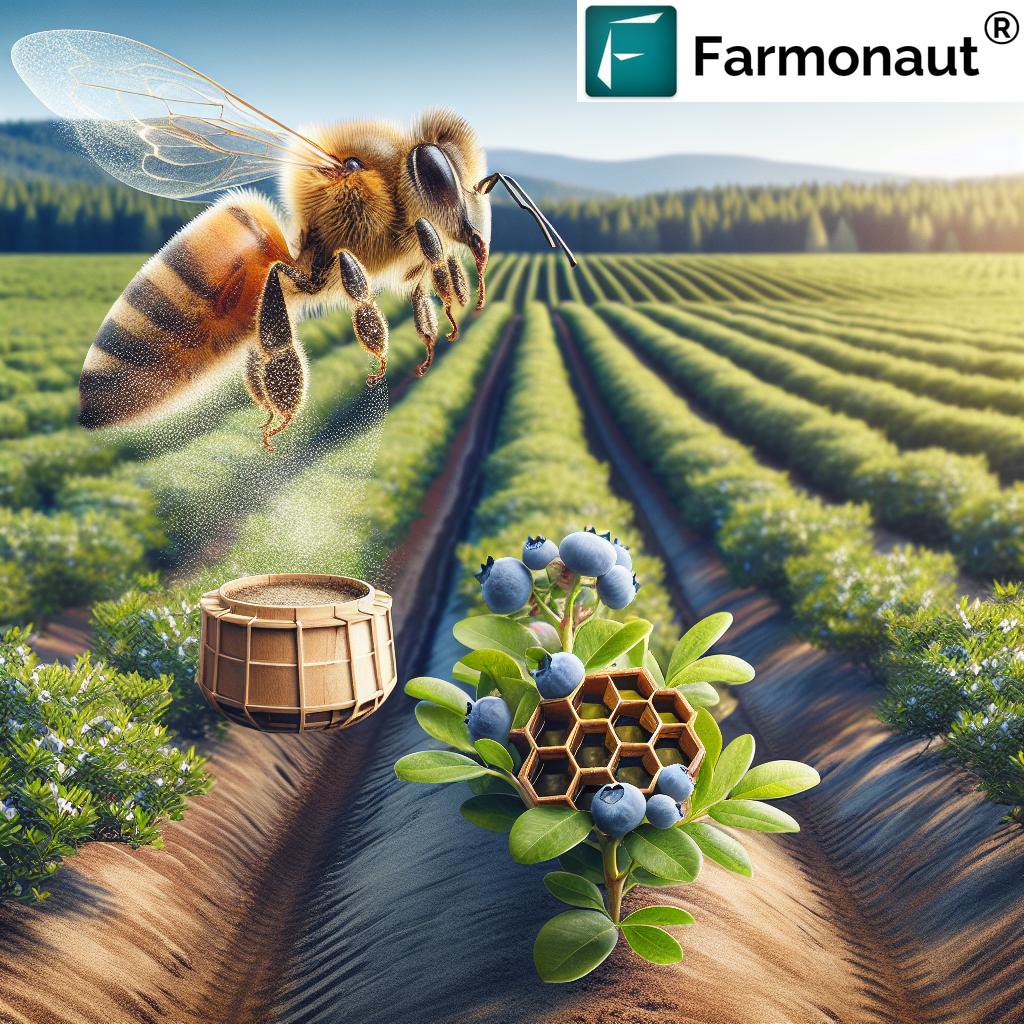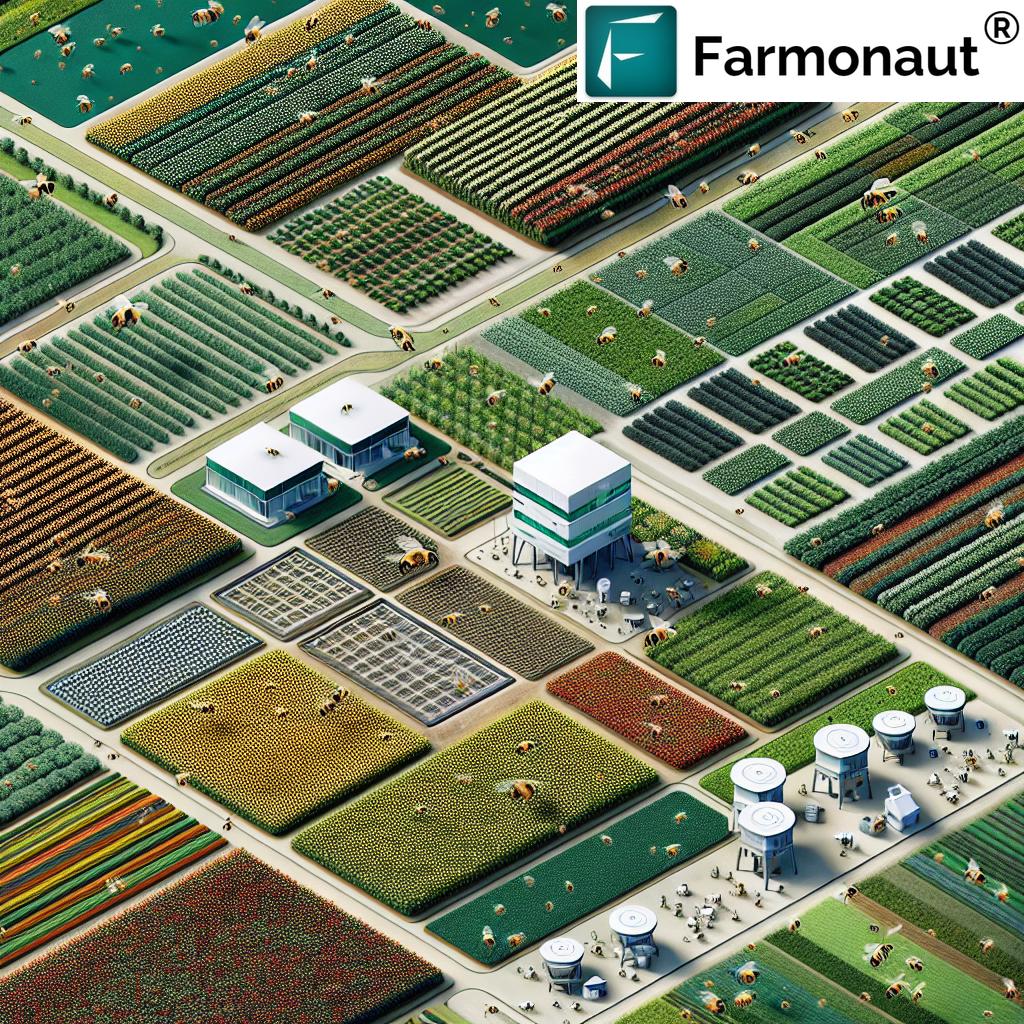Revolutionizing Crop Protection: How Bee Vectoring Technology is Boosting Yields in Georgia’s Blueberry Farms
“Bee vectoring technology has increased blueberry yields by up to 30% in Georgia farms.”
In the ever-evolving world of agriculture, we are witnessing a remarkable revolution in crop protection methods. At the forefront of this innovation is bee vectoring technology, a groundbreaking approach that combines the natural pollination abilities of bees with precision agriculture techniques. This blog post delves into how this sustainable crop protection method is transforming farming practices, with a particular focus on its impressive impact on Georgia’s blueberry farms.
Understanding Bee Vectoring Technology
Bee vectoring technology is an innovative pest management system that utilizes commercially reared bees to deliver biological crop protection solutions directly to plants. This natural precision agriculture technique harnesses the power of nature to combat crop diseases and pests while simultaneously enhancing pollination.
Here’s how it works:
- Specially designed hives are equipped with trays containing organic, powdered crop protection products.
- As bees exit the hive, they walk through this powder, which adheres to their bodies.
- The bees then deliver these active ingredients to the crops as they pollinate, providing targeted protection exactly where it’s needed.
This eco-friendly disease control method not only manages pests but also contributes significantly to sustainable farming techniques.
The Impact on Georgia’s Blueberry Farms
Georgia, known for its thriving blueberry industry, has become a prime example of how bee vectoring technology can revolutionize crop protection and boost yields. Blueberry farmers in the state have reported remarkable results since adopting this innovative approach:
- Yield Increases: Farms using bee vectoring have seen yield increases of up to 30%.
- Disease Reduction: Significant reductions in common blueberry diseases have been observed.
- Improved Fruit Quality: The dual action of enhanced pollination and targeted disease control has led to better fruit quality.

These results highlight the potential of bee vectoring as a game-changer in sustainable crop protection and natural precision agriculture.
Expanding Beyond Blueberries: A Versatile Solution
While the success in Georgia’s blueberry farms is impressive, bee vectoring technology has shown promising results across various crops:
- Strawberries: Farmers have reported increased yields and reduced gray mold incidence.
- Tomatoes: Improved fruit set and reduced disease pressure have been observed.
- Sunflowers: Enhanced pollination has led to better seed production.
- Apples: Improved fruit quality and reduced fungal diseases have been noted.
- Canola: Increased yield and oil content have been reported.
This versatility demonstrates the broad applicability of bee vectoring as a biological crop protection solution across different agricultural sectors.
The Science Behind Bee Vectoring
At the heart of bee vectoring technology is the use of beneficial microorganisms, particularly Clonostachys rosea. This naturally occurring fungus acts as a powerful ally in crop protection:
- Disease Control: C. rosea competes with harmful pathogens, preventing their establishment on plants.
- Plant Growth Promotion: It stimulates plant growth and enhances root development.
- Stress Tolerance: Plants treated with C. rosea show improved resistance to environmental stresses.
By leveraging these biological mechanisms, bee vectoring offers a sustainable alternative to traditional chemical pesticides.
Global Expansion and Market Potential
“The global market for bee vectoring technology is projected to reach $100 million by 2025.”
The success of bee vectoring technology is not limited to Georgia or even the United States. This agricultural biotechnology solution is gaining traction internationally:
- Brazil: Recent developments have opened up the Brazilian market for bee vectoring, particularly in strawberry production.
- Turkey: Successful trials in Turkish crops have paved the way for market expansion in this region.
- Europe: Several European countries are exploring the potential of this technology for various crops.
This global interest underscores the potential of bee vectoring as a key player in the future of sustainable agriculture.
Economic Benefits for Farmers
The adoption of bee vectoring technology offers significant economic advantages for farmers:
- Improved Gross Margins: Higher yields and reduced input costs lead to better profitability.
- Reduced Labor Costs: The system requires less manual application of crop protection products.
- Access to Premium Markets: The eco-friendly nature of the technology can open doors to organic and sustainable markets.
These economic benefits make bee vectoring an attractive option for farmers looking to enhance their bottom line while embracing sustainable practices.

Environmental Sustainability
One of the most compelling aspects of bee vectoring technology is its positive environmental impact:
- Reduced Chemical Use: By delivering targeted biological solutions, it minimizes the need for broad-spectrum pesticides.
- Water Conservation: The system requires no additional water for application, unlike traditional spraying methods.
- Biodiversity Support: By promoting bee health and reducing harmful chemicals, it supports local ecosystems.
This alignment with environmental sustainability makes bee vectoring a key technology in the movement towards more eco-friendly farming practices.
Integrating Bee Vectoring with Precision Agriculture
The synergy between bee vectoring and other precision agriculture techniques is opening new frontiers in farm management. At Farmonaut, we recognize the potential of combining these innovative approaches:
- Satellite-Based Crop Monitoring: Our advanced satellite imagery can help farmers identify areas that may benefit most from bee vectoring application.
- AI-Driven Insights: Our Jeevn AI advisory system can provide recommendations on optimal bee vectoring strategies based on crop health data.
- Blockchain Traceability: For crops treated with bee vectoring, our blockchain solutions can ensure transparent tracking from farm to consumer.
By integrating these technologies, farmers can maximize the benefits of bee vectoring while optimizing overall farm management.
Explore Farmonaut’s precision agriculture solutions:
Challenges and Future Developments
While bee vectoring technology shows immense promise, there are challenges to address:
- Regulatory Approvals: Gaining approval in new markets can be a complex process.
- Farmer Education: Educating farmers about this new technology and its benefits is crucial for wider adoption.
- Expanding Crop Applications: Research is ongoing to expand the range of crops and pathogens that can be addressed with this technology.
Future developments in bee vectoring are likely to focus on:
- New Biological Formulations: Developing a wider range of biological crop protection products compatible with bee vectoring.
- Improved Hive Designs: Enhancing hive technology to improve efficiency and ease of use.
- Integration with Digital Agriculture: Further integrating bee vectoring with precision agriculture technologies for optimized farm management.
Comparative Analysis of Bee Vectoring Technology in Different Crops
| Crop Type | Yield Increase (%) | Disease Incidence Reduction (%) | Economic Benefits (Estimated Gross Margin Improvement) | Environmental Impact (Pesticide Reduction %) |
|---|---|---|---|---|
| Blueberries (Georgia) | Up to 30% | 25-40% | 15-20% increase | Up to 80% |
| Strawberries (California) | 20-25% | 30-35% | 10-15% increase | 70-75% |
| Tomatoes (Brazil) | 15-20% | 20-30% | 8-12% increase | 60-65% |
| Sunflowers (Turkey) | 10-15% | 15-25% | 5-10% increase | 50-55% |
This table clearly demonstrates the significant impact of bee vectoring technology across various crops and regions. The consistent improvements in yield, disease reduction, and economic benefits, coupled with substantial reductions in pesticide use, underscore the potential of this technology as a game-changer in sustainable agriculture.
The Role of Intellectual Property in Advancing Bee Vectoring
The development and success of bee vectoring technology rely heavily on robust intellectual property (IP) protections. Companies at the forefront of this innovation have invested significantly in research and development, resulting in a portfolio of patents that cover various aspects of the technology:
- Hive Designs: Patents on specialized hive structures that facilitate the efficient distribution of biological agents.
- Biological Formulations: Proprietary formulations of beneficial microorganisms optimized for bee vectoring.
- Application Methods: Patented techniques for applying and maintaining biological agents within the hive system.
These IP protections not only safeguard the innovations but also encourage further research and development in the field, driving the technology forward.
Integrating Bee Vectoring with Farm Management Systems
To maximize the benefits of bee vectoring technology, integration with comprehensive farm management systems is crucial. At Farmonaut, we offer solutions that can complement and enhance the effectiveness of bee vectoring:
- Satellite-Based Crop Monitoring: Our advanced satellite imagery can help identify areas of the field that may require more focused attention from bee vectoring applications. By pinpointing areas of stress or disease early, farmers can optimize the deployment of bee vectoring resources.
- AI-Driven Advisory: Our Jeevn AI system can analyze crop health data in conjunction with bee vectoring applications to provide tailored recommendations for optimal crop management.
- Weather Forecasting: Accurate weather predictions are crucial for effective bee vectoring. Our weather forecasting tools can help farmers plan the best times for hive placement and bee activity.
For more information on how our technologies can support precision agriculture practices like bee vectoring, visit our API page or explore our API Developer Docs.
The Future of Crop Protection: A Sustainable Vision
As we look to the future of agriculture, bee vectoring technology stands out as a beacon of sustainable innovation. Its ability to merge natural processes with cutting-edge science offers a glimpse into a future where crop protection is both highly effective and environmentally responsible.
Key aspects of this vision include:
- Reduced Chemical Dependency: A shift away from traditional pesticides towards biological solutions.
- Enhanced Biodiversity: Supporting pollinator populations while protecting crops.
- Precision Application: Targeted delivery of crop protection agents exactly where and when they’re needed.
- Integration with Digital Agriculture: Seamless incorporation with other precision farming technologies for holistic farm management.
As this technology continues to evolve and expand, we anticipate seeing its application in an ever-widening array of crops and agricultural settings, potentially reshaping the landscape of global agriculture.
Conclusion: A New Era in Sustainable Crop Protection
Bee vectoring technology represents a significant leap forward in the quest for sustainable and effective crop protection methods. Its success in Georgia’s blueberry farms is just the beginning of what promises to be a transformative approach to agriculture worldwide.
By harnessing the natural behaviors of bees and combining them with advanced biological formulations, this technology offers a solution that is not only highly effective but also aligns perfectly with the growing demand for environmentally friendly farming practices.
As we continue to face challenges such as climate change, population growth, and the need for sustainable food production, innovations like bee vectoring technology will play a crucial role in shaping the future of agriculture. It’s a testament to human ingenuity and our ability to work in harmony with nature to solve complex problems.
At Farmonaut, we’re excited to be part of this agricultural revolution, offering complementary technologies that can enhance and support innovative approaches like bee vectoring. Together, we’re working towards a future where agriculture is more productive, sustainable, and in tune with the natural world.
FAQs
- Q: How does bee vectoring technology work?
A: Bee vectoring technology uses specially designed hives where bees walk through trays containing organic, powdered crop protection products. As they exit the hive, these products adhere to their bodies, and are then delivered to plants during pollination. - Q: Is bee vectoring safe for the bees?
A: Yes, the biological agents used in bee vectoring are specially formulated to be safe for bees and other beneficial insects. - Q: Can bee vectoring completely replace traditional pesticides?
A: While bee vectoring can significantly reduce the need for traditional pesticides, it’s often used as part of an integrated pest management strategy rather than a complete replacement. - Q: What types of crops can benefit from bee vectoring?
A: Bee vectoring has shown promise in a variety of crops including blueberries, strawberries, tomatoes, sunflowers, apples, and canola, among others. - Q: How does bee vectoring contribute to sustainable agriculture?
A: Bee vectoring reduces the use of chemical pesticides, supports pollinator populations, and improves crop yields without negative environmental impacts, aligning with sustainable farming principles.






